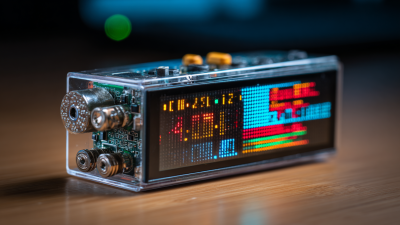In recent years, circular LCD displays have emerged as a captivating innovation within the technology landscape, redefining how information is presented in various applications. According to a report by MarketsandMarkets, the global electronic display market is projected to grow from $128.4 billion in 2020 to $175.9 billion by 2025, with circular designs playing a crucial role in this growth due to their unique aesthetic appeal and versatility. The adoption of circular LCD displays can be seen across several sectors, including automotive, wearables, and smart home devices, where they enhance user experiences by providing a more intuitive and engaging interface.
As businesses and consumers increasingly prioritize aesthetic design alongside functionality, the demand for circular LCD displays continues to rise. For instance, a study conducted by Grand View Research reveals that the automotive segment is expected to witness significant growth, with circular displays being incorporated into dashboards and infotainment systems to provide essential information in a visually attractive format. This trend is not limited to traditional displays; circular LCD technology is also gaining traction in the smartwatch and fitness tracker market, where discerning consumers seek stylish yet informative combinations. Consequently, understanding the technology behind circular LCD displays is critical for leveraging their potential in everyday applications and driving future innovations in the display industry.

Circular LCD displays represent a novel advancement in display technology, combining aesthetics with functionality. At the core of their design is a liquid crystal layer that manipulates light to produce images. This technology relies on the alignment of liquid crystals between two polarized filters. By applying an electric field, these crystals can change their orientation, consequently altering the passage of light and creating visuals. The circular format allows for a more immersive viewing experience, making these displays particularly appealing for applications where space and design are critical.
The circular form factor is increasingly being utilized in various everyday applications, including smartwatches, automotive dashboards, and innovative home appliances. These displays not only enhance the user interface but also offer users quick access to information in a compact design. Their unique shape also supports creative UI designs that traditional rectangular screens cannot achieve, fostering a more engaging interaction.
As technology advances, circular LCD displays are likely to become more prevalent, pushing the boundaries of how we consume information and interact with our devices.
The growing interest in circular displays is driven by innovative advancements that align closely with sustainable development goals. Recent partnerships, such as those between packaging solutions companies and major beverage brands, illustrate the commitment to creating fully recyclable display solutions. Notably, these initiatives not only enhance product visibility but also contribute to a broader circular economy by minimizing waste. According to industry reports, the global sustainable packaging market is projected to reach USD 500 billion by 2028, underscoring the increasing demand for environmentally friendly display technologies.
Furthermore, advancements in digital cockpit technologies highlight the shift toward integrating circular principles within automotive displays. Innovations in remanufactured products, such as infotainment screens, are setting new standards in sustainability while meeting consumer expectations for high performance. Research indicates that remanufactured products can reduce emissions by up to 30%, reflecting the potential benefits of embracing circular designs in various industries. As companies continue to innovate, the development of circular LCD displays is set to redefine not only user experiences but also overall environmental footprints.
Circular LCD displays are revolutionizing the way we interact with consumer electronics, offering unique shapes and functionalities that enhance usability in everyday applications. The global LCD display market is projected to reach significant growth, driven by demand in sectors ranging from smartphones to home appliances. According to recent industry analyses, the LCD segment continues to dominate the market, accounting for a substantial share, while circular displays are gaining traction due to their aesthetic appeal and versatility.
In consumer electronics, circular LCD displays are increasingly utilized in wearables, kitchen gadgets, and smart home devices. These displays not only save space but also provide a seamless user experience by allowing information to be presented in a more intuitive format. For example, smartwatches often use circular displays to optimize the viewing area for notifications and applications.
**Tip:** When considering devices with circular LCD displays, ensure they offer customizable features to maximize your experience. Additionally, look for products with durable display technology that can withstand everyday use, which is crucial in maintaining functionality over time.
| Application Area | Description | Key Features | Benefits |
|---|---|---|---|
| Smartwatches | Compact, round displays for fitness and notifications. | High-resolution, touch-sensitive, customizable interfaces. | Enhanced user experience, portable, and stylish design. |
| Kitchen Appliances | Circular displays used in microwaves and coffee machines. | User-friendly interfaces, bright visibility, easy settings. | Intuitive operation, modern look, energy-efficient. |
| Home Security Systems | Circular displays for status monitoring and alarms. | Real-time updates, easy navigation, customizable alerts. | Increased security awareness, user engagement, streamlined control. |
| Automotive Displays | Round instrumentation for speedometers and dashboards. | Durable, weather-resistant, clear visibility. | Enhanced driving experience, safety through visibility. |
Circular LCD displays have gained popularity for specific applications, primarily in smartwatches and specialized devices. Their round design is notably different from traditional rectangular displays, which have dominated the market for years. While rectangular screens are designed for a broader range of software applications and functions, circular displays require purpose-made content that optimally fits their shape. Consequently, the user experience can differ significantly between display types, with rectangular screens excelling at multitasking and circular screens offering a unique aesthetic appeal.
When considering the practicality of circular versus rectangular displays, it is essential to recognize their inherent strengths. Circular displays can create a more immersive experience in contexts like fitness tracking or when conveying notifications. However, the rectangular form is often more functional for applications involving complex data or multiple notifications, as it allows for more efficient use of space.
Tip 1: When designing applications for circular screens, prioritize simple, well-defined content that fits well within the display's confines.
Tip 2: For new products, evaluate whether the form factor supports the intended functionality; sometimes, a round design might look appealing, but it could compromise usability.
Tip 3: Stay updated with the latest advancements in display technology to find the best fit for your product's goals, balancing aesthetic appeal with practical functionality.
As circular LCD display technologies evolve, the industry is witnessing a significant shift towards more immersive and user-centric designs. According to a report by MarketsandMarkets, the global circular display market is projected to reach USD 7.5 billion by 2025, growing at a CAGR of 8.7% from 2020. This growth is driven by the increasing demand for innovative display solutions that enhance user experience across various applications, from automotive dashboards to wearable technology.
The future potential of circular displays extends into augmented reality (AR) and smart home devices, where traditional rectangular screens may no longer suffice. Companies like LG and Samsung are actively investing in research to produce flexible and smaller circular displays that can seamlessly integrate into everyday products. For instance, circular screens can create a more intuitive user interface for smartwatches, where the round shape mimics traditional timepieces, thereby enhancing functionality while maintaining aesthetic appeal. Additionally, the advertising sector is beginning to adopt this technology, with circular digital signage being more engaging and eye-catching, concurring with a report from Insider Intelligence that highlights a rise in consumer engagement when exposed to innovative display formats.






